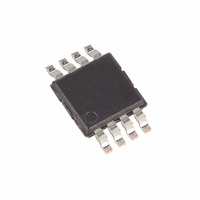MAX7411CUA+ Maxim Integrated Products, MAX7411CUA+ Datasheet - Page 8

MAX7411CUA+
Manufacturer Part Number
MAX7411CUA+
Description
IC FILTER LOWPASS 5TH 8UMAX
Manufacturer
Maxim Integrated Products
Datasheet
1.MAX7408CUA.pdf
(12 pages)
Specifications of MAX7411CUA+
Filter Type
Elliptic, Lowpass Switched Capacitor
Frequency - Cutoff Or Center
15kHz
Number Of Filters
1
Max-order
5th
Voltage - Supply
4.5 V ~ 5.5 V
Mounting Type
Surface Mount
Package / Case
8-MSOP, Micro8™, 8-uMAX, 8-uSOP,
For Use With
MAXFILTERBRD+ - BOARD EVAL MAX7408/7415/418-7425
Lead Free Status / RoHS Status
Lead free / RoHS Compliant
5th-Order, Lowpass, Elliptic,
Switched-Capacitor Filters
8
Figure 1. 5th-Order Ladder Elliptic Filter Network
The MAX7408/MAX7411/MAX7412/MAX7415 family of
5th-order, elliptic, lowpass filters provides sharp rolloff
with good stopband rejection. All parts operate with a
100:1 clock-to-corner frequency ratio and a 15kHz
maximum corner frequency.
Most switched-capacitor filters (SCFs) are designed
with biquadratic sections. Each section implements two
pole-zero pairs, and the sections can be cascaded to
produce higher order filters. The advantage to this
approach is ease of design. However, this type of
design is highly sensitive to component variations
if any section’s Q is high. The MAX7408/MAX7411/
MAX7412/MAX7415 use an alternative approach, which
is to emulate a passive network using switched-capaci-
tor integrators with summing and scaling. The passive
network may be synthesized using CAD programs, or
may be found in many filter books. Figure 1 shows a
basic 5th-order ladder elliptic filter structure.
A switched-capacitor filter that emulates a passive lad-
der filter retains many of the same advantages. The
component sensitivity of a passive ladder filter is low
when compared to a cascaded biquadratic design,
PIN
_______________________________________________________________________________________
1
2
3
4
5
6
7
8
+
-
V
NAME
SHDN
R
IN
COM
GND
OUT
V
CLK
S
OS
IN
DD
C1
Common Input Pin. Biased internally at mid-supply. Bypass externally to GND with 0.1µF capacitor. To
override internal biasing, drive with an external supply.
Filter Input
Ground
Positive Supply Input, +5V for MAX7408/MAX7411 or +3V for MAX7412/MAX7415
Filter Output
Offset Adjust Input. To adjust output offset, bias OS with a resistive voltage-divider between an external
supply and ground. Connect OS to COM if no offset adjustment is needed.
Shutdown Input. Drive low to enable shutdown mode; drive high or connect to V
Clock Input. Connect an external capacitor (C
frequency. To override the internal oscillator, connect to an external clock.
C2
L2
Detailed Description
C3
C4
L4
C5
R
L
because each component affects the entire filter shape
rather than a single pole-zero pair. In other words, a
mismatched component in a biquadratic design has a
concentrated error on its respective poles, while the
same mismatch in a ladder filter design spreads its
error over all poles.
Lowpass elliptic filters such as the MAX7408/MAX7411/
MAX7412/MAX7415 provide the steepest possible
rolloff with frequency of the four most common filter
types (Butterworth, Bessel, Chebyshev, and elliptic).
The high Q value of the poles near the passband edge
combined with the stopband zeros allows for the sharp
attenuation characteristic of elliptic filters, making these
devices ideal for anti-aliasing and post-DAC filtering in
single-supply systems (see the Anti-Aliasing and Post-
DAC Filtering section).
In the frequency domain, the first transmission zero
causes the filter’s amplitude to drop to a minimum level.
Beyond this zero, the response rises as the frequency
increases until the next transmission zero. The stop-
band begins at the stopband frequency, f
cies above f
at f
where the filter output attenuation falls just below the
passband ripple. The transition ratio (r) is defined as
the ratio of the stopband frequency to the corner fre-
quency:
The MAX7408/MAX7412 have a translation ratio of 1.6
and typically 53dB of stopband rejection. The
MAX7411/MAX7415 have a transition ratio of 1.25 (pro-
viding a steeper rolloff) and typically 37dB of stopband
rejection.
OSC
FUNCTION
S
) from CLK to GND to set the internal oscillator
. The corner frequency, f
S
, the filter’s gain does not exceed the gain
r = f
Elliptic Characteristics
S
/ f
DD
C
Pin Description
C
, is defined as the point
for normal operation.
S
. At frequen-











